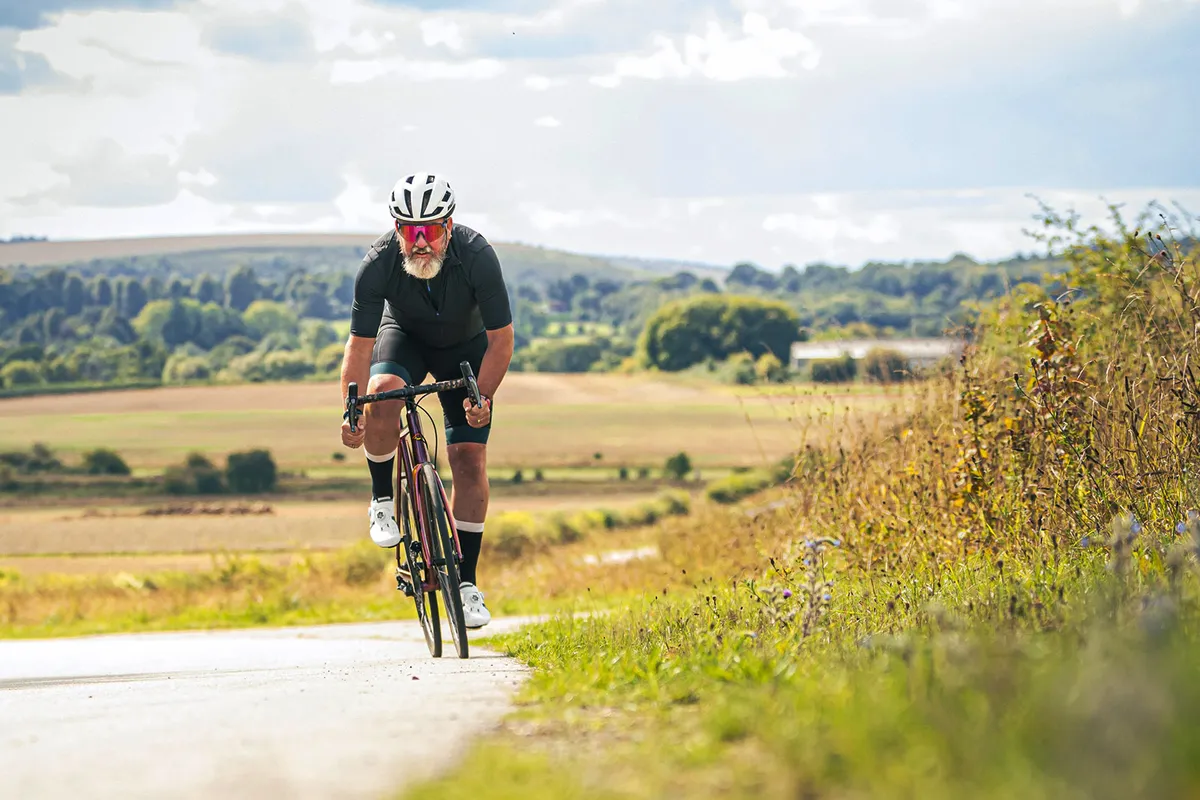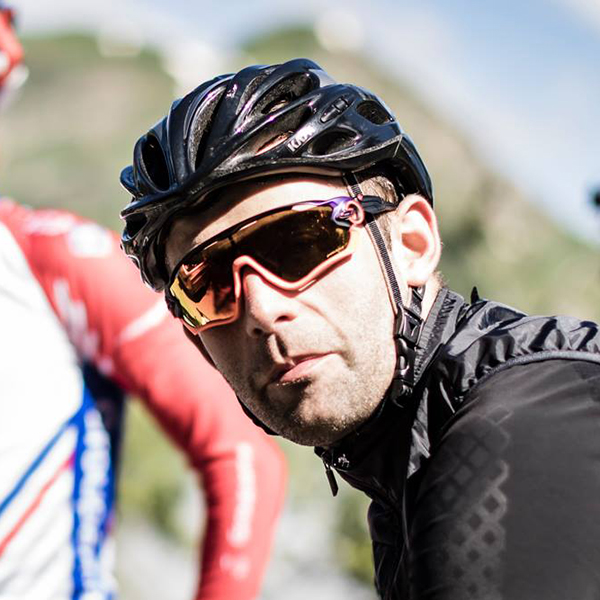SQUIRREL_13138572
The Cinelli Nemo Tig Disc is a throwback to how racing bikes used to be, but encapsulates most of the modern sensibilities that are commonplace in 2024.
A contemporary race geometry provides the Nemo Tig Disc with entertainingly sharp handling, while being easy-going enough to ride at a more social tempo.
The classic lug at the junction of the top tube and seat tube adds an air of retro style, which blends well with a carbon fork and disc brakes.
There are some shortcomings in this build and the frame’s limited tyre clearance is a minor shame, but there’s plenty to like here if a classico-modern bike is up your street.
The bike I tested would cost you £5,799.
Cinelli Nemo Tig Disc frameset

The frame is constructed using triple-butted Columbus Spirit steel tubes, which have been custom-drawn for the Nemo Tig Disc.
Cinelli says the frame is assembled by a single frame builder from “start to finish”.
For those concerned with their carbon footprint (ignoring shipping to your local dealer), the tubes are manufactured a short walk from Cinelli’s factory front door in Milan, Italy.
In a nod to steel racing bikes of yesteryear, the junction of top tube, seat tube and seatstays has a lugged design – whereby the tubes are welded into a joining piece, rather than directly to each other.

Cinelli says this has been chosen to minimise stress in this area and reduce unwanted frame flex. This incorporates a seat-clamp collar.
Despite the classic aesthetic, the frame features internal cable routing, with brake hoses entering at the top of the down tube and fork shoulder.
The head tube sees 1-½ to 1-⅛-inch bearings used, which accommodate a Columbus Futura carbon fork.
The frameset uses standard thru-axles, with the rear dropouts moulded for added stiffness.
Clearance is limited to 28mm-wide tyres – on the narrow side for modern race bikes. Unlike some brands, it’s unlikely you’ll be able to go any wider in reality (judging from the remaining space on my test bike).

The frame is said to tip the scales at 1,850g in a size 56cm, with the fork adding a further 440g.
It uses a BSA threaded bottom bracket, although custom frames can be made using a press-fit 86.5mm standard if you prefer.
Cinelli also offers a series of metallic paint finishes (one of which is demonstrated on the test bike), which definitely helps set it apart in a crowd.
Cinelli Nemo Tig Disc geometry

The size-XL frame is marketed as a 59cm equivalent by Cinelli – while the seat tube measurement (from the centre of the bottom bracket to the top of the seat tube) is bob on 59cm, it doesn’t tell the whole story.
Compared to a 58cm Specialized Tarmac SL8, for example, the Nemo Tig’s reach is 7mm shorter and the stack 4mm lower.
As someone accustomed to riding bikes in the 56-58cm window, I had feared the Nemo Tig would feel on the large side – but it fit me well (I’m 188cm tall, for context), especially when I swapped the supplied setback seatpost for an inline one.

Importantly for race-bike handling, the head tube angle is 73 degrees and the fork features a 45mm offset – only 1mm longer than the Tarmac.
The seat tube angle (also 73 degrees) helps to pitch the rider over the bottom bracket – in theory, this helps open the hip angle for more efficient power transfer.
| | XS | S | M | L | XL | XXL |
|---|---|---|---|---|---|---|
| Seat tube angle (degrees) | 74.5 | 74 | 73.5 | 73.5 | 73 | 72 |
| Head tube angle (degrees) | 71 | 71.5 | 72.5 | 73 | 73 | 73.5 |
| Chainstay (mm) | 410 | 410 | 410 | 410 | 410 | 410 |
| Front centre (mm) | 572 | 573 | 575 | 585 | 605 | 609 |
| Seat tube C-T (mm) | 480 | 510 | 540 | 560 | 590 | 610 |
| Seat tube C-C (mm) | 455 | 485 | 515 | 535 | 565 | 585 |
| Top tube - eff (mm) | 510 | 520 | 535 | 550 | 575 | 590 |
| Top tube - act (mm) | 505 | 516 | 531 | 545 | 570 | 584 |
| Head tube (mm) | 110 | 120 | 145 | 160 | 185 | 210 |
| Fork offset (mm) | 45 | 45 | 45 | 45 | 45 | 45 |
| Bottom bracket drop (mm) | 70 | 70 | 70 | 70 | 70 | 70 |
| Wheelbase (mm) | 972 | 973 | 975 | 985 | 1005 | 1009 |
| Stack (mm) | 510 | 520 | 547 | 564 | 587 | 613 |
| Reach (mm) | 369 | 371 | 373 | 383 | 395 | 397 |
Cinelli Nemo Tig Disc specification

The Cinelli Nemo Tig Disc is available as a frameset only – this can, of course, be built using a collection of compatible parts, or through your local distributor, which should be able to help source specific components.
Chicken Cycle Kit is Cinelli’s UK distributor, and this informed much of the test build – this model costs £5,799.
The wheels and finishing kit are from Italian brand Deda Elementi – a Route SL4 DB Carbon wheelset is most notable, with a claimed 1,520g weight.

These feature 45mm-deep rims with a 19mm internal and 26mm external width, which is relatively narrow by modern standards.
Many brands are settling at around 21mm or wider internally, with external widths pushing over 30mm, to support the use of wider tyres.
That said, a narrower wheelset is a more understandable choice in the context of the frame’s limited 28mm tyre clearance.
This is because a 700x28c tyre (as fitted) should inflate to 28mm-wide on a 19mm rim, in theory.

The Continental Ultra Sport clincher tyres fitted measure up at 27.9mm, but leave some performance on the table compared to the best tubeless tyres. Chicken Cycle Kit tells us it would usually fit Schwalbe One Performance TLE tyres – a tier shy of the top-spec Schwalbe Pro One TLE, but better for tubeless fans.
A Deda Elementi Zero handlebar and stem form the basis of the cockpit, and a Zero seatpost provides the platform for the Prologo Scratch M5 saddle, with alloy rails.
Shimano’s Ultegra Di2 R8100 groupset serves for the gears and brakes, with a few switch-outs.
The rotors are from Tektro, while the 11-32-tooth cassette is supplied by Tifosi. A KMC chain has been used.

While all are a departure from the standard Shimano fare, they performed well. I’m not sure the Tektro rotors offer the same level of ‘feel’ as Ultegra-level M8100 or CL800 models, but the differences are small, at most. The biggest contrast is aesthetic.
Bearing in mind you’re at liberty to build the Nemo Tig how you like, it’s not as easy to verify the relative value of the £5,799 price tag as it would be with an off-the-peg bike. The frameset costs £2,299 (subject to paint variations) and you can take it from there.
With the suggested build as tested, though, top-spec tubeless tyres and a carbon seatpost are not a stretch to expect at this price, given what can be bought industry-wide in 2024.
Cinelli Nemo Tig Disc ride impressions

The Cinelli Nemo Tig Disc strikes a balance between sharp, racy handling and the smooth ride quality the best steel road bikes are renowned for.
Among its test cohort of non-carbon race bikes, it comes strikingly close to delivering the ride quality offered by the titanium-framed J.Laverack R.Jack Disc Race. Certainly, it’s smoother than the firm, scandium alloy Standert Kreissäge RS.
That said, it’s far more ‘alive’ feeling – where the R.Jack Disc deadens road buzz, the Nemo Tig Disc feels more transmissive of road texture.
This brought about a sense of occasion with each ride, in that I couldn’t ‘float’ along in a relaxed manner (as I can with my own steel Fairlight Strael 3.0, for example), but needed to concentrate more keenly on the task at hand.
Don’t be fooled into thinking that just because it’s made of steel, it’ll insulate you while delivering racy handling.
With the agile handling thrown into the mix, the Nemo Tig Disc doesn’t deliver an especially relaxing ride – a ‘problem’ exacerbated by the fact that you can’t soften things further by going up a tyre size or two (or fit wider wheels without pushing the limits of clearance).

A carbon seatpost is also a clear avenue you could go down to help tackle this.
Of course, this needs to be considered in the context of the bike’s main focus: it’s a race bike, after all, rather than a bump-smoothing endurance bike.
Ridden hard, it’s very rewarding. The ride position is aggressive without pushing things to the extreme, and I could get well tucked in and get on with the job of riding fast.
Every well-executed descent or series of corners feels earned, and although a more aerodynamically optimised bike will be quicker (all things being equal), there’s a keen sense of speed on flat and rolling terrain.
The 9.32kg total weight (not including my pedals, saddle bag or bottles) means it gives up a little performance on paper when climbing, but it was still entertaining when putting an effort in.
The alloy Kreissäge RS weighs 8.36kg, while the titanium R.Jack Disc comes in at 8.84kg (with titanium cages).
The Cinelli felt stiff and responsive – able to absorb all the power I could put into it, at any rate – although not quite as whip-sharp as the alloy Standert.
If you race (or just ride hard) for fun, rather than solely for where you end up on the results sheet, the Nemo Tig Disc has much to offer.
Cinelli Nemo Tig Disc bottom line

The Cinelli Nemo Tig Disc is an interesting take on a race bike – arguably one more for connoisseurs than those focused on the results sheet or stopwatch.
It’s entertaining to ride and involves you at every turn. It’s also very pretty to look at, if you’re into a classic aesthetic.
While not harsh to ride, it offers the most transmissive ride I’ve experienced in recent times, which in turn makes it less relaxing than many other race bikes when you’re not pushing on.
Built with a more generous finishing kit (a carbon seatpost and top-level tubeless tyres would be high on my wishlist), the Nemo Tig Disc would be more well-rounded.
Happily, the option remains to spec it how you wish, so this is a possibility.
SQUIRREL_13138572
Product
| Brand | Cinelli |
| Price | £5799.00 |
| Weight | 9.32kg |
Features
| Fork | Columbus Futura, carbon |
| Stem | Deda Elementi Zero, alloy |
| Chain | KMC 12-speed |
| Frame | Cinelli Nemo Tig Disc, Columbus Spirit steel |
| Tyres | Continental Ultra Sport, 700x28c |
| Brakes | Shimano Ultegra Di2 R8100 / Tektro TR35 rotors |
| Cranks | Shimano Ultegra Di2 R8100 |
| Saddle | Prolog Scratch M5 Tirox |
| Wheels | Deda Route SL4 DB Carbon |
| Shifter | Shimano Ultegra Di2 R8100 |
| Cassette | Tifosi 12-speed HG, 11-32t |
| Seatpost | Deda Elementi Zero, alloy [18mm offset] |
| Handlebar | Deda Elementi Zero, alloy |
| Available sizes | XS, S, M, L, XL, XXL |
| Rear derailleur | Shimano Ultegra Di2 R8100 12×2 |
